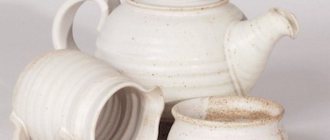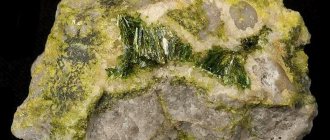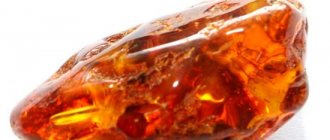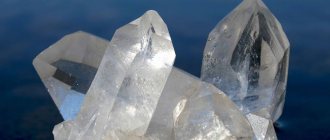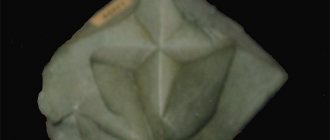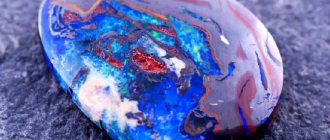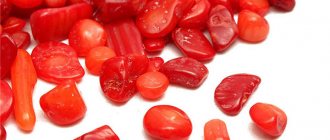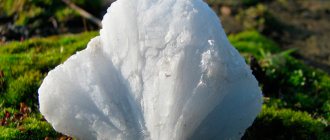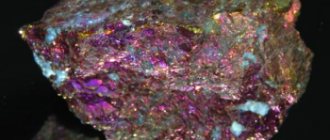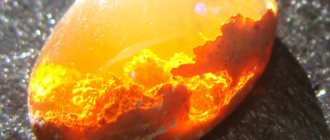Talc
- mineral with the formula Mg3Si4O10(OH)2. Synonyms: agalite (fine-fiber), steatite, wen (dense, massive). It is a greasy, crumbly powder of white (occasionally green) color. The quality of talc is determined by its whiteness. For industrial purposes, ground talc, microtalc, etc. are used. It is worth noting that talc is a mineral that is almost insoluble in water and acids. The necessary conditions for the formation of talc are a temperature of about 400 ° C, a sufficient amount of water (after the transformation of minerals from rocks rich in iron and magnesium).
- Structure
- Properties
- Morphology
- Origin
- Application
- Classification
- Physical properties
- Optical properties
- Crystallographic properties
See also:
Agate
- price and medicinal, magical properties
Physical properties and structure of diamond
STRUCTURE
The mineral talc has a crystalline (usually rhombic) structure. In nature it occurs in the form of leafy granular layers. It is a secondary mineral that is formed when magnesium silicates, which do not contain aluminum (Al), change their chemical composition.
The crystal lattice of talc is formed by a layer of magnesium oxide, framed by two layers of non-polar tetraers of quartz and oxygen. The outer surface of the flakes contains neither hydroxyl groups nor active ions, which determines the high chemical resistance and hydrophobicity of talc. Three-layer talc crystals, having a very strong internal bond, are very weakly connected to each other.
Gallery: talc stone (34 photos)
Soapstone is a type of talc
Talc is a component of many rocks. Soapstone is a massive variety that is of metamorphic origin. Another name is soapstone. It has been mined for thousands of years. It was used to make dishes that were not afraid of fire and slowly gave off heat. The rock consists mainly of talc with varying amounts of other minerals (chlorite, magnesite). The color of soapstone is gray, bluish, green, brown or mottled. Since its main component is talc, it has properties similar to it. This makes soapstone a valuable material for many applications. Physical properties include:
- softness and ability to cut easily;
- high density and lack of porosity;
- heat resistance and high thermal conductivity;
- ability to absorb moisture;
- resistance to alkalis and acids.
The mineral and chemical composition are not constant, which is why its physical properties can vary among different minerals and even within the same rock. This depends on the source material, temperature conditions and pressure.
Where is talc mined (video)
The level of metamorphism often determines the grain size of the steatite and its hardness.
The special properties of the rock allow soapstone to be widely used in many areas:
- production of countertops and sinks;
- creation of decorative carvings;
- construction of stoves and fireplaces;
- making dishes;
- use as a construction and finishing material;
- metal casting molds;
- making marker pencils.
Due to its properties, soapstone is used for medical purposes as a natural heating pad, since it can retain heat for a long time.
PROPERTIES
Talc is a recognized standard of softness of natural materials. Color ranges from light apple green to white and silvery white, sometimes yellowish. The luster is greasy, pearlescent on the cleavage planes. The cleavage is very perfect. Translucent at the edges, transparent in thin leaves. The cleavage is very perfect according to (001). Hardness 1 (minimum) on the Mohs scale. Oily to the touch. Under the blowpipe it turns white and breaks up into small sheets; melts with difficulty, forming white enamel on the edges.
Authenticity
- IR spectrum The infrared spectrum of the substance, taken in a disk with potassium bromide, in the region from 4000 to 400 cm-1 should have absorption bands at wave numbers 3677, 1018 and 669 cm-1.
- Qualitative reaction. 0.1 g of the substance is fused at a temperature of 850 to 900 ºC in a platinum crucible with a mixture consisting of 0.2 g of anhydrous sodium carbonate and 2 g of potassium carbonate. The alloy is allowed to cool and transferred to an evaporation dish using 50 ml of hot water. Hydrochloric acid diluted 10% is carefully added to the alloy until the formation of bubbles stops, then another 10 ml of hydrochloric acid diluted 10% is added. The resulting solution is evaporated to dryness in a water bath. Add 20 ml of water to the residue, bring to a boil and filter through a paper filter.
To 5 ml of filtrate add 1 ml of 10% ammonia solution, 1 ml of 10.7% ammonium chloride solution and filter through a paper filter. when 1 ml of 9% disodium hydrogen phosphate solution is added to the resulting filtrate, a white crystalline precipitate (magnesium) is formed.
- Qualitative reaction. The filter cake is placed in a platinum crucible, 10 mg of sodium fluoride and 0.2 ml of concentrated sulfuric acid are added, the crucible is covered with a transparent flat plastic lid, on which a drop of water is placed on the inside, and carefully heated; A white ring (silicon) forms around the drop.
MORPHOLOGY
Depending on the structure and mineral additives, some types of talc have their own names. Thus, minnesoaite is a talc in which magnesium is isomorphically replaced by iron. It has a brownish color. Willemseite - magnesium in the mineral formula is isomorphically replaced by nickel (stone color - green, blue).
Very dense, massive talc is called steatite or wen. Not so common is talc, which consists of long, tangled, parallel-fibrous, asbestos-like crystals. It is called agalite.
There are also very beautiful varieties of talc aggregate - dense, white and translucent, which tolerate stone cutting and polishing well. They are called noble talc.
In deposits, talc is found together with chlorite, clinochlore, serpentinite, tremolite, and other minerals of the pyroxene and amphibole groups. can form aggregates when mixed with chlorite (talc chlorite).
What does talc treat and what is useful?
Talc has a generally beneficial effect on the human body. Powder made from the mineral is used mainly externally. Useful powder when used in moderation:
- absorbs sweat and reduces friction, helps prevent and eliminate skin rash;
- has a beneficial effect on prickly heat;
- cools the skin and eliminates itching and irritation;
- promotes softening and healing of the epidermis;
- allows you to keep your body fresh in hot weather;
- unclogs contaminated pores and helps regulate the functioning of the sebaceous glands;
- eliminates discomfort and unpleasant odor due to excessive sweating of the feet.
The powder is used for massage - it acts like a soft scrub, removes dead particles of the epidermis and creates slip. Choosing talc instead of oily mixtures is especially recommended if you have a lot of body hair. The powder is used for wax depilation of excess vegetation. The body skin is treated with talc before and after the procedure - this helps prevent irritation and protects against ingrown hairs.
Talcum powder does not stain clothes and this compares favorably with most deodorants
ORIGIN
Talc is formed as a result of the interaction of dolomites and water from hot springs. Soapstones of various impurity composition are a consequence of the reactions of silicic acid decomposition of magnesian rocks.
Talc deposits are ubiquitous. However, only in Brazil are large (up to 5 cm) crystals of talc covered with a quartz crust found. The United States has remained the champion in industrial talc production for many years. Canada, France, Russia, and the countries of the Far East are famous for the development of high-quality talc.
In Russia, the Shabrovo talc-magnesite and Miass talcite deposits are being developed in the Middle Urals, the Onotskoye deposit of steatite (solid) talc (Eastern Sayan); The Western Baikal talconiferous province has been identified. Abroad, large deposits are known in Canada (Maidoc), USA (Gavernur), France (Luzenac), etc.
The magic of mineral
Practicing magicians use talc in the preparation of anti-aging potions, including drinks and creams.
This mineral is not used as an amulet, amulet or talisman.
Very rarely, magicians and sorcerers use talc in their rituals. And only white magic wizards do this. This mineral is very kind and positive. It cannot be used to cast a spell or enchantment that promotes anything negative.
But to improve home energy, having decorative elements from it or lining walls with it in one of the rooms is simply necessary. In this case, not a single ill-wisher will cross his threshold. Talc will act as a talisman of goodness and psychological well-being for all inhabitants of such a home, including pets.
Talc in astrology
Talc does not have any effect on people born under any of the zodiac signs - neither positive nor negative. Connoisseurs of the magical properties of minerals cannot say for sure which zodiac sign is protected by talc.
This mineral does not have a great internal energy message, but talc, nevertheless, is focused only on good.
APPLICATION
This mineral has long been firmly established in various areas of human activity and life. Since the end of the nineteenth century, it has been used as a powder that is used to coat rubber, caoutchouc, and plastic technical products so that they do not stick together upon contact. In the sex industry, it is used for storing all kinds of toys by treating surfaces with talc-based powders. In the notorious "magical practice" talc was used to prepare potions, with the help of which, as some believed, youth and beauty could be restored; these were various creams and ointments that acted on the skin as cosmetics, but nothing more.
Since about the same time, finely ground talc has been used as baby powder. This mineral can decompose in the human stomach and be a source of magnesium and calcium (used in calcium gluconate preparations, dietary supplements).
Talc is used as an additive and filler in foods. The European Food Standardization Organization calls it food additive E553b.
Talc is a filler for tablets, paper pulp, varnishes and paints, ceramics, cosmetic products, and insulators. This mineral is even added to motor oils as an additive, which increases the life of engines.
An important area of application is ceramics (especially radio-insulating).
Talc - Mg3Si4O10(OH)2
| Molecular weight | 379.27 g/mol |
| origin of name | from Persian "talc" to Arabic "talq", - pure |
| IMA status | valid, first described before 1959 (before IMA) |
Story
The magic of the mineral is in its influence on our appearance. Healthy teeth and clean skin have been valued at all times. The sorcerers of Arabia and the Maghreb (territory of Morocco) used soapstone figurines as amulets.
Unprocessed talc
In history, finely ground talc powder “lit up” among the northern peoples. Soapstone beads and amulets protected their health.
Educational: soapstone figurines are found in the tombs of Ancient Egypt.
PHYSICAL PROPERTIES
| Mineral color | colorless, white, greenish-white, pale green |
| Stroke color | white |
| Transparency | translucent, opaque |
| Shine | greasy, pearly, dull |
| Cleavage | very perfect in {001} |
| Hardness (Mohs scale) | 1 |
| Kink | not uniform |
| Strength | cut and easily wrinkled |
| Density (measured) | 2.58 - 2.83 g/cm3 |
| Radioactivity (GRapi) | 0 |
Substances soluble in water
No more than 0.2%.
To 10 g of the substance add 50 ml of water free of carbon dioxide and reflux for 30 minutes. After cooling, the solution is filtered through a paper filter into a 50 ml volumetric flask, the volume of the solution is adjusted to the mark with water free of carbon dioxide and mixed. 25 ml of the filtrate is evaporated to dryness, the precipitate is dried in an oven at a temperature of 105 ºC for 1 hour and weighed. The mass of the residue should not exceed 10 mg.
OPTICAL PROPERTIES
| Type | biaxial (-) |
| Refractive indices | nα = 1.538 – 1.550 nβ = 1.589 – 1.594 nγ = 1.589 – 1.600 |
| Maximum birefringence | δ = 0.051 |
| Optical relief | moderate |
| Pleochroism | weak colorless, pale green |
| Dispersion | r > v tangible |
| Luminescence in ultraviolet radiation | fluorescent, with short-wave UV - orange-yellow, with long-wave UV - yellow |
Acidity
To 2.5 g of the substance add 50 ml of water free of carbon dioxide and reflux for 30 minutes. After cooling, the solution is filtered under vacuum. To 10 ml of filtrate add 0.1 ml of 0.04% solution of bromothymol blue; when adding no more than 0.4 ml of 0.01 M hydrochloric acid solution, a green color should appear.
To 10 ml of filtrate add 0.1 ml of 1% phenolphthalein solution; when adding no more than 0.3 ml of 0.01 M sodium hydroxide solution, a pink color should appear.
Arsenic
No more than 0.0005%. The determination is carried out in accordance with the requirements of the General Pharmacopoeia Monograph “Arsenic”. 1.5 g of the substance is placed in a glass, moistened with 3 ml of 96% alcohol, added 10 ml of diluted hydrochloric acid 8.3%, 20 ml of water, heated in a water bath at a temperature of 40 to 50 ºС for 15 minutes and filtered through a paper filter. blue ribbon filter into a 100 ml volumetric flask. The glass and filter with the residue are washed with hot water, collecting the washing water in a volumetric flask. After cooling, bring the volume of the solution to the mark with water and mix. 6.7 ml of the resulting solution is taken for analysis.
The benefits and harms of taklk
Talcum powder has more benefits than harm, but it still exists. This mineral is constantly being studied, during which scientists have found that it can be dangerous.
If you inhale mineral dust or powder for a long time, you can become a victim of a very unpleasant disease called talcosis. This disease is inherent in people whose occupation deals with mineral dust every day. In addition, oncologists have put forward their own version: talc, in certain situations, can act as a carcinogen and provoke the onset of cancer. It is noteworthy that this theory has not been confirmed.

